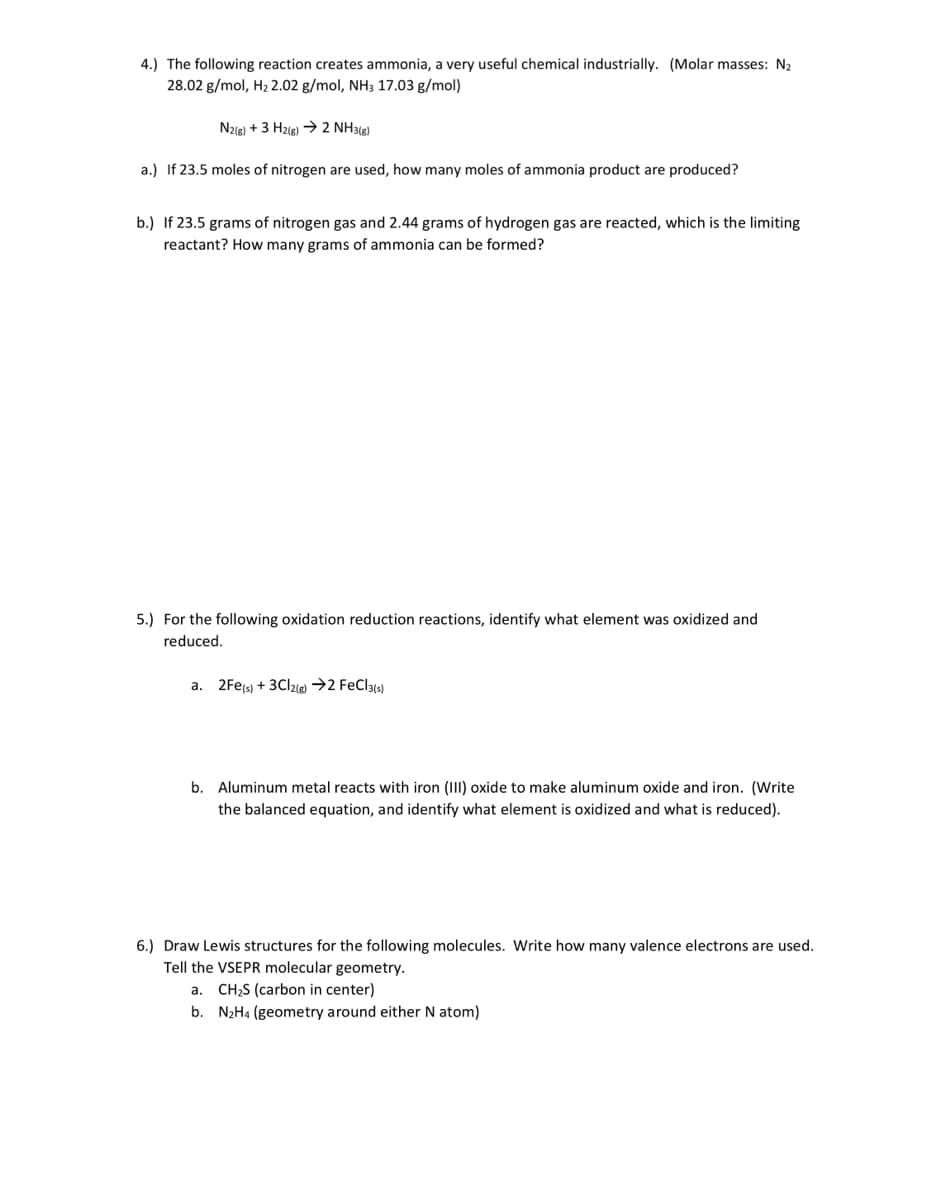4.) The following reaction creates ammonia, a very useful chemical industrially. (Molar masses: N2 28.02 g/mol, H2 2.02 g/mol, NH; 17.03 g/mol) Naia) + 3 Hze) > 2 NH3sia) a.) If 23.5 moles of nitrogen are used, how many moles of ammonia product are produced? b.) If 23.5 grams of nitrogen gas and 2.44 grams of hydrogen gas are reacted, which is the limiting reactant? How many grams of ammonia can be formed?
4.) The following reaction creates ammonia, a very useful chemical industrially. (Molar masses: N2 28.02 g/mol, H2 2.02 g/mol, NH; 17.03 g/mol) Naia) + 3 Hze) > 2 NH3sia) a.) If 23.5 moles of nitrogen are used, how many moles of ammonia product are produced? b.) If 23.5 grams of nitrogen gas and 2.44 grams of hydrogen gas are reacted, which is the limiting reactant? How many grams of ammonia can be formed?
Chemistry: The Molecular Science
5th Edition
ISBN:9781285199047
Author:John W. Moore, Conrad L. Stanitski
Publisher:John W. Moore, Conrad L. Stanitski
Chapter3: Chemical Reactions
Section: Chapter Questions
Problem 65QRT
Related questions
Question
100%

Transcribed Image Text:4.) The following reaction creates ammonia, a very useful chemical industrially. (Molar masses: N2
28.02 g/mol, H2 2.02 g/mol, NH3 17.03 g/mol)
N2le) + 3 Hzle) → 2 NH3(e)
a.) If 23.5 moles of nitrogen are used, how many moles of ammonia product are produced?
b.) If 23.5 grams of nitrogen gas and 2.44 grams of hydrogen gas are reacted, which is the limiting
reactant? How many grams of ammonia can be formed?
5.) For the following oxidation reduction reactions, identify what element was oxidized and
reduced.
a. 2Fe(s) + 3CI216) →2 FeClats)
b. Aluminum metal reacts with iron (III) oxide to make aluminum oxide and iron. (Write
the balanced equation, and identify what element is oxidized and what is reduced).
6.) Draw Lewis structures for the following molecules. Write how many valence electrons are used.
Tell the VSEPR molecular geometry.
a. CH;S (carbon in center)
b. N2H4 (geometry around either N atom)
Expert Solution
This question has been solved!
Explore an expertly crafted, step-by-step solution for a thorough understanding of key concepts.
This is a popular solution!
Trending now
This is a popular solution!
Step by step
Solved in 4 steps

Knowledge Booster
Learn more about
Need a deep-dive on the concept behind this application? Look no further. Learn more about this topic, chemistry and related others by exploring similar questions and additional content below.Recommended textbooks for you

Chemistry: The Molecular Science
Chemistry
ISBN:
9781285199047
Author:
John W. Moore, Conrad L. Stanitski
Publisher:
Cengage Learning

General Chemistry - Standalone book (MindTap Cour…
Chemistry
ISBN:
9781305580343
Author:
Steven D. Gammon, Ebbing, Darrell Ebbing, Steven D., Darrell; Gammon, Darrell Ebbing; Steven D. Gammon, Darrell D.; Gammon, Ebbing; Steven D. Gammon; Darrell
Publisher:
Cengage Learning


Chemistry: The Molecular Science
Chemistry
ISBN:
9781285199047
Author:
John W. Moore, Conrad L. Stanitski
Publisher:
Cengage Learning

General Chemistry - Standalone book (MindTap Cour…
Chemistry
ISBN:
9781305580343
Author:
Steven D. Gammon, Ebbing, Darrell Ebbing, Steven D., Darrell; Gammon, Darrell Ebbing; Steven D. Gammon, Darrell D.; Gammon, Ebbing; Steven D. Gammon; Darrell
Publisher:
Cengage Learning


Chemistry: An Atoms First Approach
Chemistry
ISBN:
9781305079243
Author:
Steven S. Zumdahl, Susan A. Zumdahl
Publisher:
Cengage Learning

Chemistry
Chemistry
ISBN:
9781305957404
Author:
Steven S. Zumdahl, Susan A. Zumdahl, Donald J. DeCoste
Publisher:
Cengage Learning

Chemistry: Principles and Reactions
Chemistry
ISBN:
9781305079373
Author:
William L. Masterton, Cecile N. Hurley
Publisher:
Cengage Learning